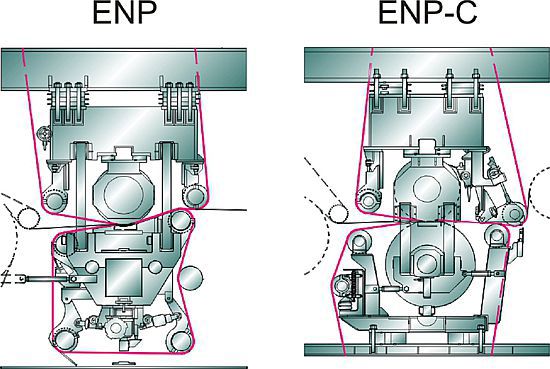Smooth extended nip press (ENP) change-out, a case study
Apr 4, 2022
As a shutdown of its No. 1 machine approached, a southern USA mill contacted Valmet to supervise the change-out of the extended nip press (ENP) module. A Valmet technical service engineer would also inspect the machine for mechanical and hydraulic problems while running and assist with press alignment and adjustments.

The open and closed ENP designs
An electronic nip impression (NipScan) was made using tactile pressure transducers. This involved placing sensors every 250 mm in the cross direction of the nip and additional sensors down the width of the shoe in the machine direction. Data from the sensors was routed to proprietary software and plotted on a computer. Differences in pressure were displayed on graphs in different colors.

A NipScan image shows the pressure profile going through the press nip
The measurements during this visit indicated that the nip was loading evenly in the cross direction. It was also good in the machine direction.
The Valmet field service representative spent the day before the downtime looking over the press and hydraulic units to spot potential problems to be fixed. Those items were discussed with the maintenance supervisor in a pre-shutdown meeting that afternoon, and included the following:
- The front side adjustment and alignment link were loose while the machine was running. Both font and back alignment pins needed to be pinned and turnbuckles tightened. The module was moving and the front side link was loose, allowing the module to oscillate about 0.1 inch in the machine direction.
- The backside alignment link was not pinned to the module frame while the machine was running. It needed to be connected and adjusted to hold alignment while the machine was operating.
- The cross-machine alignment link was connected.
- B-Shur flow orifices on the backside of the machine were out of the specified operating position. All were reset correctly to the required set-up position.
The day of the down, the Valmet expert supervised the change-out of the module. That included checking alignment and then repositioning the unit so that the shoe squared to the centerline of the controlled crown (CC) roll. A NipScan after the alignment verified that the press was set up correctly.
The Valmet engineer suggested increasing the blanket tension to eliminate fingering. Although the machine was dryer-limited, the various improvements reduced steam use by roughly 10-15%. Steam flow increased from about 165 lbs to 250 lbs, making it possible to speed up the machine. Caliper also improved.
For more information on maintenance and upgrades for shoe presses, contact your Valmet representative.